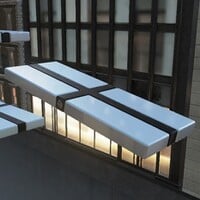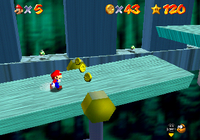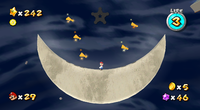Seesaw
- This article is about the recurring object throughout the Mario franchise. For the object from Wario: Master of Disguise, see Seesaw (Wario: Master of Disguise).
| Seesaw | |||
|---|---|---|---|
 Screenshot from Super Mario Odyssey | |||
| First appearance | Super Mario World 2: Yoshi's Island (1995) | ||
| Latest appearance | Mario & Luigi: Brothership (2024) | ||
| Effect | Platform that tilts under the weight of a character | ||
| Variant of | Lift | ||
| |||
| |||
- “GWAHAHA! I loaded my latest fortress with traps. I even threw some Seesaws in there. Good luck balancing those out. GWAHAHA!”
- —Father of Name Withheld, Super Mario Maker 2
Seesaws are lifts in the Super Mario franchise. They are usually airborne and they tilt left or right, depending on where the player character is standing. In some games, enemies and rolling obstacles also tilt seesaws. They are often suspended above bottomless pits.
History[edit]
Yoshi franchise[edit]
Super Mario World 2: Yoshi's Island[edit]
Seesaws,[1] also referred to as teeter-totters,[1][2] first appear in Super Mario World 2: Yoshi's Island, where one is first found in the hidden ! Switch area in The Cave Of Chomp Rock. In this bonus area, a Yoshi must tilt the seesaw to collect the coins; if he falls off, he can no longer reach them and is forced to leave the area. A seesaw also appears in Burt The Bashful's Fort and in King Bowser's Castle. A smaller wooden seesaw also called a teeter-totter also appears in the game.
Yoshi's Story[edit]
Varyingly sized seesaws,[3] also referred to as tilting platforms,[4] appear in Poochy & Nippy and Frustration in Yoshi's Story. They are made of wood and suspended above bottomless pits. Standing on one end of a seesaw tilts it and allows the Yoshi to reach higher areas. In addition to appearing throughout the stage, seesaws occur during the boss battle with Cloudjin in Poochy & Nippy, who tosses spiked balls. They cause the platform the shift and throws the Yoshi off-balance. Egg Blocks appear above them too. The eggs roll down tilted seesaws when expelled.
In part of Frustration, a Lakitu tosses spiked balls above the seesaws, like Cloudjin. They cause the platform the shift and throws the Yoshi off-balance. In the last portion, a melon is located near the bottom of the stage and requires standing on the left corner of a long seesaw to reach.
Yoshi's New Island[edit]
In Yoshi's New Island, seesaws appear in Seesaw Scramble and Gargantua Blargg Attacks! Teeter-totters also appear in the former level.
Yoshi's Woolly World / Poochy & Yoshi's Woolly World[edit]
In Yoshi's Woolly World and its port, seesaws appear in the levels Big Montgomery's Fort and Lava Scarves and Red-Hot Blarggs.
Super Mario series[edit]
Super Mario 64 / Super Mario 64 DS[edit]
Seesaws[5] appear throughout Super Mario 64 and Super Mario 64 DS. Their designs and shape vary depending on the course, often matching the local topography. A thin, wooden seesaw is located near the Chain Chomp on the Bob-omb Battlefield. It is suspended by a thin stone like the small teeter-totters in the Yoshi's Island series, though it does not collapse if the player character stands on one of its ends for too long. This seesaw is above a dry riverbed patrolled by Bob-ombs.
Wider seesaws appear in Bowser in the Dark World, Bowser in the Fire Sea, The Secret Under the Moat, Rainbow Ride, and Bowser in the Sky. These ones are fastened to pivots in the center and are suspended above bottomless pits or lava. Some of the ones in Bowser in the Fire Sea and Bowser in the Sky are unconventionally shaped and oblong. Most of these seesaws appear to made of stone, except for the one in The Secret Under the Moat, which appears wooden.
Super Mario Advance 4: Super Mario Bros. 3[edit]
In Super Mario Advance 4: Super Mario Bros. 3, two seesaws appear in the World-e level A Towering Tour. Players can make them tilt left or right by placing themselves on the corresponding side, and the Seesaws can do a full 360° rotation.
New Super Mario Bros.[edit]
In New Super Mario Bros., two seesaws appear in World 1-2. One of them allows the player to access a gap at the top of the level, where the third Star Coin and the secret exit are located. They behave the same as the larger variant in Super Mario World 2: Yoshi's Island.
Super Mario Galaxy 2[edit]
In the Boo Moon Galaxy of Super Mario Galaxy 2, a crescent-shaped seesaw called the teeter-totter moon[6] appears suspended in the sky. It shifts back and forth based on where Mario is standing on it. During Silver Stars Pop-Up, Star Chips appear above the teeter-totter moon that need to be collected to form a Launch Star. The moon otherwise appears in the game's credits, surrounded by Lumas.
New Super Mario Bros. 2[edit]
Seesaws return in New Super Mario Bros. 2, only appearing in World 2-2 and World 6-5. They behave as they did in New Super Mario Bros.
Super Mario 3D World / Super Mario 3D World + Bowser's Fury[edit]
The seesaws in Super Mario 3D World have convex divots at opposite corners to keep spiked rollers from rolling off their sides. Standing on one corner causes the spiked roller to roll along the surface, making navigation hazardous. They are otherwise varyingly designed. In Tricky Trapeze Theater, the seesaws are fastened to the sides of aqueducts and suspended above empty space. These ones are colorful and lined with lights. The seesaws in Spooky Seasick Wreck are made of wood and varyingly shaped, similar to Super Mario 64. The one at the end of the course is conventionally shaped and suspended above ground by wooden beams. This seesaw can be tilted to reach the top of the course's Goal Pole.
Super Mario Odyssey[edit]
In Super Mario Odyssey, Seesaws first in New Donk City after Mario and Cappy complete A Traditional Festival! A scarecrow occurs in the northwest corner of the city. Striking it causes three black and white seesaws to appear fastened to the side of a skyscraper for a brief period of time. They behave as they do in previous games, shifting under Mario's weight. Hopping between the seesaws brings Mario to the Metro Kingdom Timer Challenge 1 Power Moon. If he is standing on one when the time limit runs out, he falls down a pit. The black and white design of these seesaws matches those of the other temporary platforms that appear during Timer Challenges in New Donk City.
Seesaws subsequently appear in an otherworldly sub-area in the Mushroom Kingdom. These ones are orange with yellow centers, and they are the one of the view available platforms in this location. Fruit appear above them, and eating them all as Yoshi awards Mario with the Yoshi's Feast in the Sea of Clouds Power Moon.
Super Mario Maker 2[edit]
Seesaws appear as a course element in Super Mario Maker 2. They are colored orange in the Super Mario World style, and red in all other styles. In the Super Mario Bros., Super Mario Bros. 3, and Super Mario World styles, they appear to be metallic, but in the New Super Mario Bros. U style, they are wooden. Like normal Lifts, their length can be changed, and they can be placed on tracks. They work similarly to their appearance in Super Mario Advance 4: Super Mario Bros. 3 (with the Super Mario Bros. 3-styled ones even resembling them), in that they tilt left or right depending on the player's or an enemy's position, but they can no longer do a full 360° rotation. Seesaws are absent from the Super Mario 3D World style, despite appearing in the source game.
Seesaws can be abruptly tilted when a Thwomp falls on one side, throwing any playable characters and objects on the other side high into the air. This can also be achieved if a player Ground Pounds on the Seesaw (requiring a Dry Bones Shell to do so in the Super Mario World style and either a Dry Bones Shell or a big Goomba's Shoe in the Super Mario Bros. and Super Mario Bros. 3 styles). Furthermore, Bowser can perform this as well in the Super Mario Bros. 3 style using his Ground Pound attack.
The following is a table listing the different weights of each course element.[7]
In addition to these weight values:
- Variations of a course element almost always weigh the same as their parent. This includes different forms of the player character.
- Applying the Super Mushroom modifier to a course element doubles its weight. Wings and parachutes, on the other hand, contribute nothing to the weight.
- While Giant Eggs have an initial weight value of 2×, the value becomes 1× once Red Yoshi hatches from the egg.
- Pokeys and Snow Pokeys in particular have their weight multipliers increase by one for each segment added.
Unused appearances[edit]
While Seesaws do not appear in New Super Mario Bros. Wii, they appear without custom textures in the game's code, implying that they were originally meant to appear within the game.
Profiles[edit]
Super Mario Maker 2[edit]
- Website description:
- English (United States):
These are perfect for risky, tilt-centric courses.
- English (United States):
Gallery[edit]
Sprites and models[edit]
Super Mario Maker 2 (Super Mario Bros. style)
Super Mario Maker 2 (Super Mario Bros. 3 style)
Super Mario Maker 2 (Super Mario World style)
Screenshots[edit]
Names in other languages[edit]
Seesaw[edit]
| Language | Name | Meaning | Notes |
|---|---|---|---|
| Japanese | シーソー[?] Shīsō |
Seesaw | |
| シーソーリフト[8] Shīsō Rifuto |
Seesaw Lift | ||
| Chinese (Simplified) | 跷跷板[?] Qiāoqiāobǎn |
Seesaw | |
| Chinese (Traditional) | 蹺蹺板[?] Qiāoqiāobǎn |
Seesaw | |
| Dutch | Wipplank[?] | Seesaw | |
| French | Bascule[?] | Seesaw | |
| German | Wippe[?] | Seesaw | |
| Italian | Piattaforma mobile a dondolo[9] | Rocking moving platform | |
| Altalena basculante[?] | Tilting seesaw | Super Mario Maker 2 | |
| Korean | 시소[11] Siso |
Seesaw | |
| Portuguese (Europe) | Balancé[10] | Seesaw | |
| Russian | Качалка[?] Kachalka |
Seesaw | |
| Spanish (Latin America) | Subibaja[?] | Seesaw | |
| Spanish (Europe) | Balancín[?] | Seesaw |
Teeter-totter moon[edit]
| Language | Name | Meaning | Notes |
|---|---|---|---|
| Japanese | 月のシーソー[12] Tsuki no Shīsō |
Moon Seesaw | |
| Italian | Luna altalena[13] | Seesaw moon | |
| Altalena luna[14] |
References[edit]
- ^ a b Miller, Kent and Terry Munson (1995). Super Mario World 2: Yoshi's Island Player's Guide. Nintendo Power (American English). Page 28..
- ^ Williams, Drew (2002). Yoshi's Island: Super Mario Advance 3 Player's Guide. Nintendo of America (American English). ISBN 1-930206-25-9. Page 28.
- ^ Leung, Jason, Terry Munson, and Scott Pelland. Yoshi's Story Player's Guide. Redmond: Nintendo of America (English). Page 64, 73.
- ^ ----. Yoshi's Story Player's Guide. Redmond: Nintendo of America (English). Page 64, 69, 73.
- ^ Pelland, Scott and Dan Owsen (1996). Super Mario 64 Player's Guide. Nintendo Power (American English). Page 118, 122.
- ^ Browne, Catherine (May 23, 2010). Super Mario Galaxy 2: PRIMA Official Game Guide. Roseville: Random House Inc. ISBN 978-0-30746-907-6. Page 194.
- ^ Nintendo Unity (July 2, 2019). Super Mario Maker 2 - Who is the Heaviest Character? (Weight Tier List) (prior to version 2.0)]. YouTube. Retrieved July 6, 2019.
- ^ Sakai, Kazuya (Ambit), kikai, Akinori Sao, Junko Fukuda, Kunio Takayama, and Ko Nakahara (Shogakukan), editors (2015). 『スーパーマリオブラザーズ百科: 任天堂公式ガイドブック』. Tokyo: Shogakukan (Japanese). Page 92, 118, 200.
- ^ November 15, 2018. Super Mario Bros. Enciclopedia. Magazzini Salani (Italian). ISBN 889367436X. Page 92.
- ^ Nintendo Portugal (May 15, 2019). Super Mario Maker 2 Direct - 15/05/2019. YouTube (European Portuguese). Retrieved January 10, 2021.
- ^ 한국닌텐도 공식 채널 (May 16, 2019). 슈퍼 마리오 메이커 2 Direct 2019.5.16. YouTube (Korean). Retrieved November 11, 2022.
- ^ ---- (2015). "Super Mario Galaxy 2." In『スーパーマリオブラザーズ百科: 任天堂公式ガイドブック』. Tokyo: Shogakukan (Japanese). Page 170.
- ^ Super Mario Galaxy 2 - Premiere Edition, by PRIMA Games & multiplayer.it Edizioni. Page 194.
- ^ November 15, 2018. Super Mario Bros. Enciclopedia. Magazzini Salani (Italian). ISBN 889367436X. Page 170.
- Lifts
- New Super Mario Bros. objects
- New Super Mario Bros. 2 objects
- Super Mario Advance 4: Super Mario Bros. 3 objects
- Super Mario 3D World objects
- Super Mario 64 objects
- Super Mario 64 DS objects
- Super Mario Galaxy 2 objects
- Super Mario Maker 2 objects
- Super Mario Odyssey objects
- Super Mario World 2: Yoshi's Island objects
- Yoshi's New Island objects
- Yoshi's Story objects
- Yoshi's Woolly World objects









